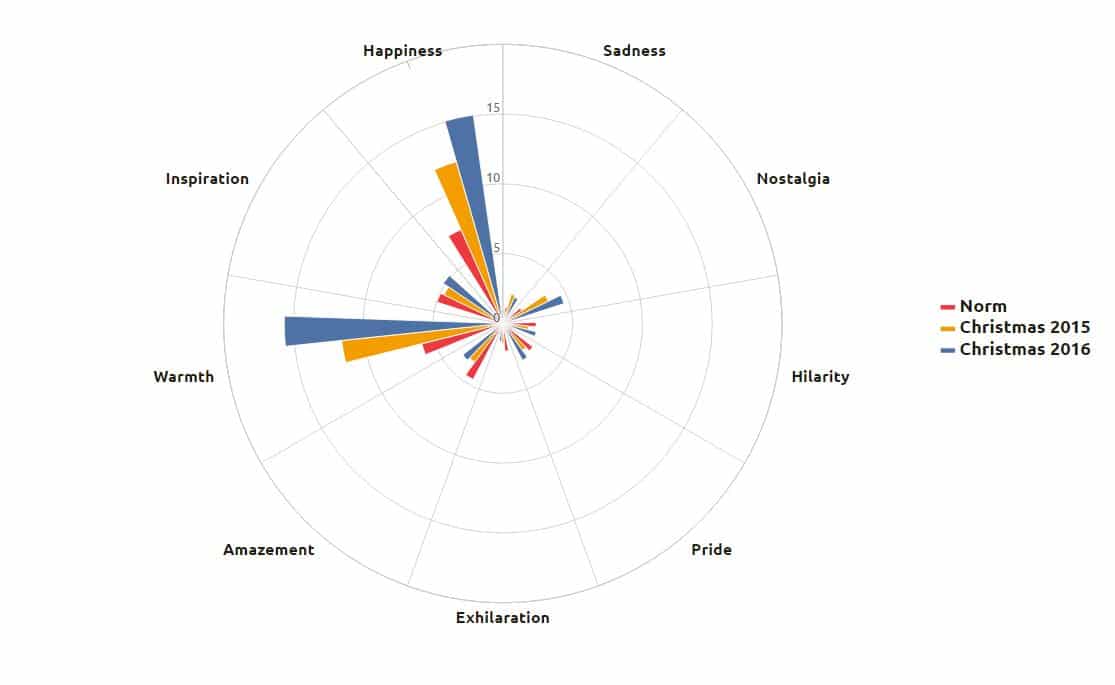Are This Year’s Christmas Ads Really Much Happier Than Last Year’s? We Have The Data…
Which emotions do you think of when you think about Christmas? Happiness and warmth, of course – it’s the season of joy and goodwill after all.
Surprise and excitement at opening presents and seeing loved ones? Sure. Nostalgia for all those Christmases you had when you were a child? Definitely.
But what about sadness? Sure, it may seem odd to talk about melancholy during the holiday period, but anyone who has had to endure TV soap EastEnders on Christmas Day will be hard pressed to think of it as the season to be jolly. Of course, this bitter, dark vein through the Christmas cheese does not just extend to soap operas. You would be hard pressed to watch a lot of the great Xmas stories without shedding a tear or two.
The Snowman, The Grinch, It’s A Wonderful Life, A Christmas Carol (even The Muppets’ version), A Christmas Story, Miracle on 34th Street, err, Love Actually – they all will have you reaching for the tissues.
Of course, this is simply good storytelling. How can we really truly feel joy if we have never experienced sadness? But you don’t need to tell brands such as John Lewis this. The retailer may be synonymous with Christmas advertising. However, it’s the brand’s skilled use of another kind of advertising that has really earned it its place at the top of the festive table: sadvertising.
Creating ads designed to make people cry – thereby creating an emotional connection between brand and consumer – was nothing new. But John Lewis took it to a new level with ads like “The Gift”, “The Journey”, “The Bear and the Hare” and “Monty the Penguin”.
But this year we saw a change in strategy from the retailer. Stung by criticism of last year’s Xmas entry “Man on the Moon”, which was seen as a little too sad and predictable, and no doubt feeling pressure to provide some much-needed light relief after a year to forget for a lot of people, John Lewis this month released the much cheerier “#BustertheBoxer”.
https://www.youtube.com/watch?v=sr6lr_VRsEo
The ad set the tone for what has been called a much lighter and happier parade of Xmas advertising this year. Far from the tear-inducing ads of 2015, such as Edeka’s controversial but highly-successful “Homecoming”, the Spanish Lottery’s brilliant “Justino”, Sainsbury’s “Mog’s Christmas Calamity” and, of course, “Man On The Moon” (to name just a few), this year’s crop has been branded a rejection of sadvertising. Or so we are told…
But does the data back this up? Well, at Unruly, we wanted to delve a little deeper to see if there has been a material change in the emotional make-up of this year’s crop of Xmas ads.
Using our content evaluation tool Unruly EQ, we compared the two sets of ads to see if 2016’s Xmas ads are much more likely to leave you feeling happier and warm inside compared to 2015’s. And whether they are less likely to make you cry.
Here is what we found:

As you can see from the chart above, the emotional make-up of 2016’s Xmas ads is indeed considerably different to 2015’s.
But are they much more likely to make people feel happy and warm inside?
Indeed, they are. This year’s more light-hearted tone means they are 25% more likely to make people feel intense feelings of happiness while watching than those released in 2015. They are also more than twice as happy to make people feel intense happiness as the average UK ad (114%). This year’s crop are also 33% more likely to make consumers feel intense feelings of warmth than those in 2015, and 167% more likely than the UK norm.
But it’s not just happiness and warmth which has soared during this year’s festive period. 2016’s Xmas ads are also 25% more likely to make people feel nostalgic than 2015 ads (twice as likely than the average UK ad) and 50% more likely to make people feel pride than 2015 ads. This year’s ads are also slightly more likely to inspire, amaze and exhilarate.
However, laughs are still at a premium in 2o16 as they were the previous year. In fact, the last two years of Xmas ads have been just as funny as the average UK ad.
But were 2016’s ads considerably less sad?
Well, not really, to be honest. Looking at the data, 2016’s Xmas commercials are still twice as sad as the average UK ad, but only 10% less likely to make consumers cry than those in 2015.
Methodology
We tested 18 Christmas commercials from 2015 and 15 Xmas ads from 2016 using our content evaluation tool, Unruly EQ. To find out how to get your content tested about, click here.
